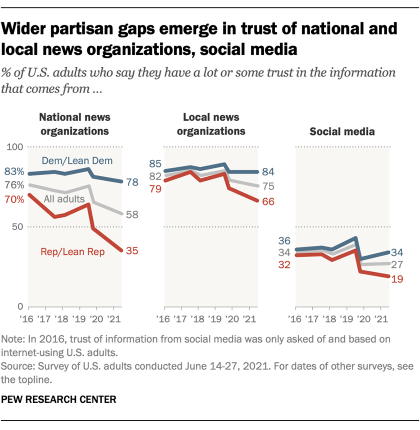In just five years, the percentage of Republicans with at least some trust in national news organizations has been cut in half – dropping from 70% in 2016 to 35% this year. This decline is fueling the continued widening of the partisan gap in trust of the media.
Nearly eight-in-ten Democrats and Democratic-leaning independents (78%) say they have “a lot” or “some” trust in the information that comes from national news organizations – 43 percentage points higher than Republicans and Republican leaners (35%) – according to a new Pew Research Center survey conducted June 14-27, 2021. This partisan gap is the largest of any time that this question has been asked since 2016. And it grows even wider – to 53 points – between liberal Democrats (83%) and conservative Republicans (30%).
The 35% of Republicans who have at least some trust in national news organizations in 2021 is half that of in 2016 (70%) – and has dropped 14 points since late 2019 (49%). By comparison, Democrats have remained far more consistent in the past five years, ranging somewhere between 78% and 86%.
To examine Americans’ trust in national and local news organizations as well as social media, Pew Research Center surveyed 10,606 U.S. adults from June 14-27, 2021. Everyone who completed the survey is a member of the Center’s American Trends Panel (ATP), an online survey panel that is recruited through national, random sampling of residential addresses. This way nearly all U.S. adults have a chance of selection. The survey is weighted to be representative of the U.S. adult population by gender, race, ethnicity, partisan affiliation, education and other categories. Read more about the ATP’s methodology. Here are the questions used for this analysis, along with responses, and its methodology.
This is the latest report in Pew Research Center’s ongoing investigation of the state of news, information and journalism in the digital age, a research program funded by The Pew Charitable Trusts, with generous support from the John S. and James L. Knight Foundation.
Overall, about six-in-ten U.S. adults (58%) say they have at least some trust in the information that comes from national news organizations. While still a majority, this is the smallest share over the past five years this question was asked. When it was last asked in late 2019, 65% expressed at least some trust. And far fewer (12%) express that they have “a lot” of trust in the information that comes from national news organizations.
Americans tend to have greater trust in local news organizations – though there is somewhat of a decline here as well. A large majority of Americans (75%) still say they have at least some trust in the information that comes from local news organizations, modestly lower than the shares who said the same in 2016 (82%) and in late 2019 (79%). And again, far fewer express the highest level of trust (18%).
A similar partisan divide emerges when it comes to local news, though to a lesser extent. As of June 2021, Democrats are 18 percentage points more likely than Republicans to have at least some trust in the information that comes from local news organizations (84% vs. 66%, respectively) – a gap that is again larger than at any time in recent years. Five years ago, 85% of Democrats had at least some trust in local news organizations, while 79% of Republicans did.
Social media continues to engender a much lower level of trust. About a quarter of Americans (27%) say they have at least some trust in the information that comes from social networking sites, with just 4% expressing that they have a lot of trust in it. This is about on par with late 2019 when 26% said they had at least some trust, but somewhat lower than the 34% who said the same in 2016. (In 2016, this question was asked of internet-using U.S. adults.)
Social media is trusted by a minority of both parties, though a partisan gap still exists. About a third of Democrats and Democratic-leaning independents (34%) and 19% of Republicans and Republican leaners say they have at least some trust in the information that comes from social media – a 15-point gap. This gap is larger than gaps from any other time in recent years and has nearly doubled since late 2019.
Note: Here are the questions used for this analysis, along with responses, and its methodology.





